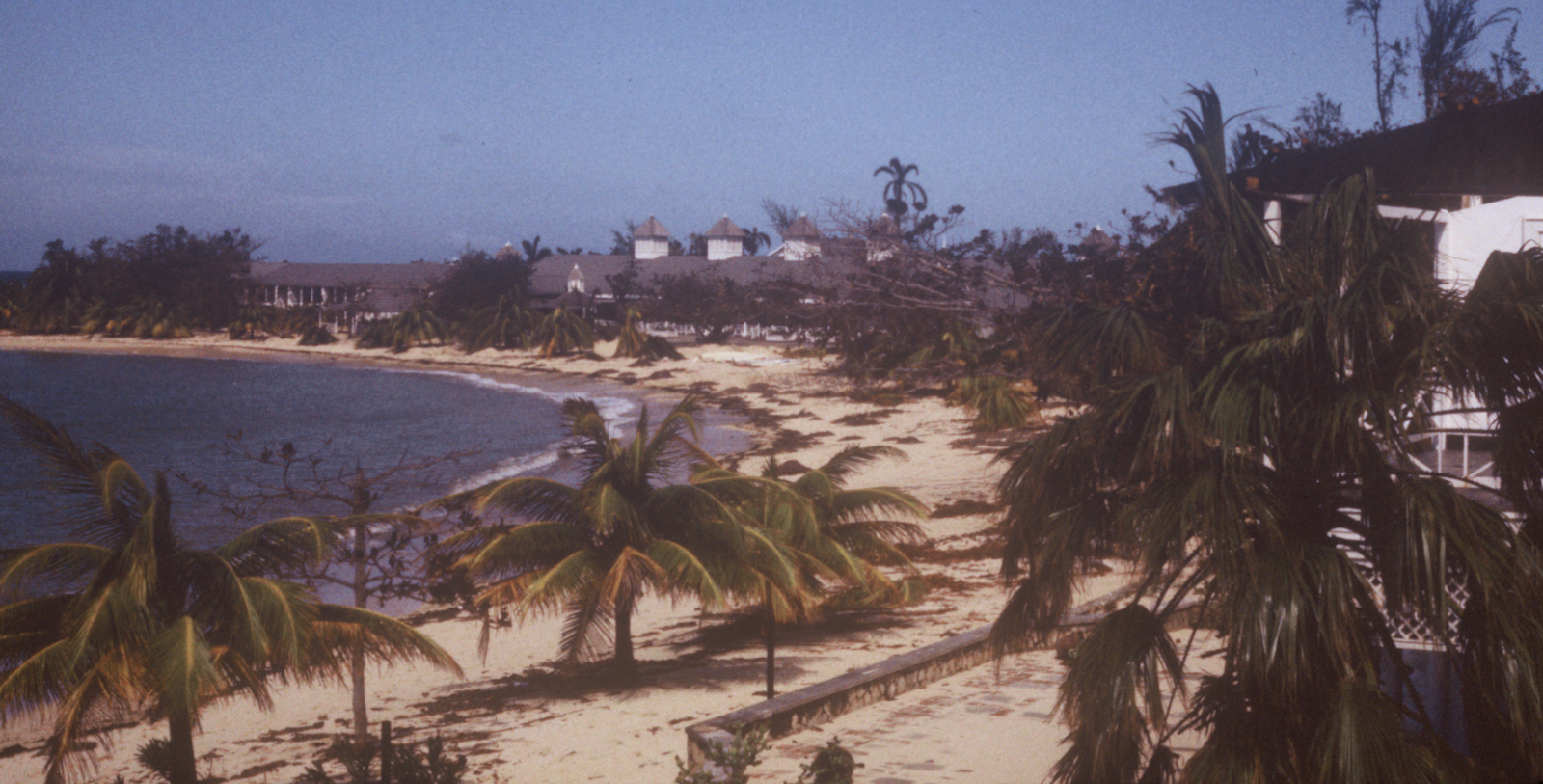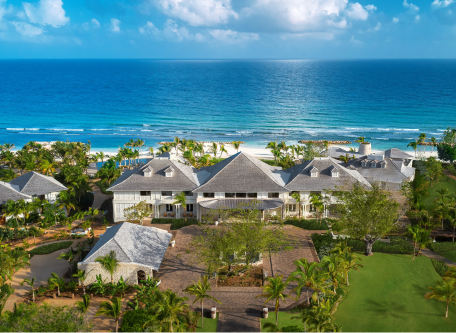Receive for Free - Discover & Explore eNewsletter monthly with advance notice of special offers, packages, and insider savings from 10% - 30% off Best Available Rates at selected hotels.
history
Discover Half Moon, which has ranked as one of Jamaica’s best resorts since the mid-20th century.
In the mid-20th century, Jamaica was rapidly turning into one of the Caribbean’s most celebrated holiday destinations. Among the most prominent retreats to open then was Half Moon, a stunning seaside resort that loomed majestically over the island’s picturesque North Coast. Its origins can be specifically traced back to 17 entrepreneurial individuals who were interested in developing a quaint vacation getaway. Hailing from Bermuda, Great Britain, and the United States, the team featured an incredible number of influential businesspeople. Indeed, the group included Harvey Firestone Jr. of the Firestone Tire and Rubber Company, Richard Reynolds of the Reynolds Metal Company, Donald Deskey, designer of Radio City Music Hall, and real estate magnate Curtis Steuart. The team quickly set about finding the perfect location upon which to construct their prospective resort, ultimately selecting a 35-acre stretch of shoreline that was part of the historic Rose Hall estate. (The land once harbored a loading dock back when Rose Hall functioned as a sugarcane plantation.) They then proceeded to construct a magnificent series of rustic cottages known as the “Cottage Colony,” as well as a central hotel building that contained more than two dozen guestrooms. Originally referred to collectively as the “Half Moon Hotel & Cottage Colony,” the entire breathtaking facility opened for the first time in 1954. It gradually earned a spectacular reputation for its warm hospitality and luxurious character over the following years. Generations of North American and European travelers particularly came to adore the resort, eager to experience the area’s tranquil, tropical environment during the winter months.
The resort’s unrivaled prestige soon began to allure many illustrious international personalities, too, such as movie stars, politicians, and royalty. In fact, some of the most noteworthy guests to visit Half Moon were members of the British Royal Family, like Queen Elizabeth II of the United Kingdom; Prince Phillip, Duke of Edinburgh; and Prince Charles, the future King Charles III of the United Kingdom. U.S. Presidents even spent time at Half Moon, including President-Elect John F. Kennedy in 1960. Recently elected to the presidency, Kennedy had arrived with his wife, First Lady Jacqueline Kennedy, mere weeks before he was slated to take office! (In fact, one of the best mementos that Half Moon has kept from their trip is a letter that Jacqueline Kennedy wrote on resort stationery.) The enduring popularity of Half Moon subsequently enabled its ownership group to continuously expand the facility over the next several decades, enlarging its size to eventually cover some 400 acres. Many magnificent facilities debuted as a result, including a verdant championship-caliber golf course designed by the revered Robert Trent Jones Sr. Today, Half Moon consists of 210 gorgeous guestrooms and suites, alongside 25 villas featuring five, six, and seven bedrooms. This iconic Caribbean resort also offers a wealth of terrific venues, like the Equestrian Centre, Fern Tree Spa, the Eclipse at Half Moon, and the award-winning Sugar Mill restaurant. Tantamount to its continuing success has been the diligence of its current owners, who descend from three of the original founders: the Steuart family, the Pearce family, and the Weiss family. Cognizant of the resort’s storied reputation and place in Jamaica’s history, the owners are dedicated to ensuring that Half Moon’s impressive legacy will always be preserved.
-
About the Location +
Located along the tranquil coastline of Jamaica’s picturesque North Coast, Montego Bay is among the most exciting places to visit on the island. It is also rich in history, with its earliest inhabitants—the Native American Taino—originally residing in the location for millennia. The Taino themselves were a South American people whom scholars believe sailed across the Caribbean Sea to reach Jamaica some 1,200 years ago. Persisting on fishing and agriculture, the Taino had established around 200 villages that functioned as the home for nearly 60,000 people. However, the fate of the Taino (including those residing near present-day Montego Bay) changed forever when Italian adventurer Christopher Columbus became the first known European to encounter Jamaica in 1494. He specifically anchored his fleet at today’s St. Ann’s Bay and navigated his way west toward Montego Bay. Referring to Montego Bay as “Golfo de Buen Tiempo” (or “Fair Weather Gulf”), Columbus and his cohort of Spanish explorers were greeted by the local Taino upon their arrival. Generations of Spanish colonists then followed in their wake, establishing small farms near the bay throughout the 16th and 17th centuries. While the rest of Jamaica became the site of heavy sugarcane cultivation, the area surrounding Montego Bay remained relatively isolated and rural in character. The only major form of economic activity was the collection and exportation of lard, which the Spanish obtained from wild hogs out in the surrounding forest. Indeed, the resident Spanish even took to calling the bay “Bahia de Manteca,” meaning “Lard Bay.” (“Manteca” was eventually simplified decades later to just “Montego.”)
But while the Spanish managed to survive, the local Taino did not due to overexposure to European diseases. Their unfortunate deaths were part of a much larger decline of the Taino elsewhere on the island, who were tragically impressed into plantation slavery by the Spanish. To find another source of labor, the Spanish turned to imported African slaves. While Montego Bay itself did not feature plantations, the wilderness located nearby acted as a haven for runaway slaves. Known as “Maroons,” the escaped slaves built their own independent communities and often resisted Spanish attempts to subjugate them. Nevertheless, the economy of Montego Bay changed drastically once the English conquered Jamaica in 1655 amid the greater Anglo-Spanish War. Indeed, English (and later British) planters began building the same sprawling plantations at Montego Bay that had mainly defined the landscape of southern Jamaica during its time as a Spanish colony. Soon enough, Montego Bay’s primary export was raw sugarcane, which remained its principal cash crop well into the 19th century. The area started to see significant urban development, too, starting with Captain Jonathan Bennett’s creation of Charles Town and Barnett Town on portions of his estate. Grand colonial mansions also began to proliferate across the countryside, such as the gorgeous Georgian-inspired manor of Rose Hall. The British even constructed an imposing fortress overlooking the bay in order to protect its shipments of sugarcane from Spanish and French pirates!
However, the plantation system was harsh for African and Afro-Jamaican slaves, who continuously fought for their freedom via several uprisings. The last (and most prominent) rebellion was the Baptist War, which a local slave named Samuel Sharpe led in 1831. Even though the revolt failed to achieve the eradication of slavery on the island, the Baptist War nonetheless galvanized the British Parliament to institute emancipation throughout all of Great Britain’s overseas colonies. (Samuel Sharpe today is hailed as a National Hero of Jamaica, and a memorial dedicated to his memory exists right in the middle of downtown Montego Bay.) In the aftermath of the Jamaican emancipation, Montego Bay’s economy gradually switched to the growth of bananas and coffee beans—crops that still continue to see widespread cultivation in the present. Tourism also became a central industry for Montego Bay around the time Jamaica achieved its independence during the mid-20th century, as its deepwater harbor provided a great alternative for the many cruise ships that typically headed to the south of the island. Furthermore, the area’s white sandy beaches and verdant flora created a wonderful environment that thousands of curious vacationers wished to experience. Montego Bay has since retained its revered reputation as a popular holiday destination, with countless people visiting each year. Cultural heritage travelers, in particular, have enjoyed exploring Montego Bay, going on to visit landmarks like Rose Hall Great House, Sam Sharpe Square, and the Green Grotto Caves. Other major metropolises are located just a few hours away on the other side of the island as well, including the historic communities of Kingston and Spanish Town.
-
Famous Historic Guests +
Clark Gable, actor known for his roles in It Happened One Night, Mutiny on the Bounty, and Gone with the Wind
Paul Newman, actor known for his roles in such films as Cool Hand Luke, The Sting, and Butch Cassidy and the Sundance Kid
Winston Churchill, Prime Minister of the United Kingdom (1940 – 1945; 1951 – 1955)
Prince Rainier III of Monaco
Princess Caroline of Monaco
Prince Phillip, Duke of Edinburgh
Queen Elizabeth II of the United Kingdom (1952 – 2022)
King Charles III of the United Kingdom (2022 – present)
Jacqueline Kennedy Onassis, First Lady of the United States (1961 – 1963)
John F. Kennedy, 35th President of the United States (1961 – 1963)
George H.W. Bush, 41st President of the United States (1989 – 1993)


























